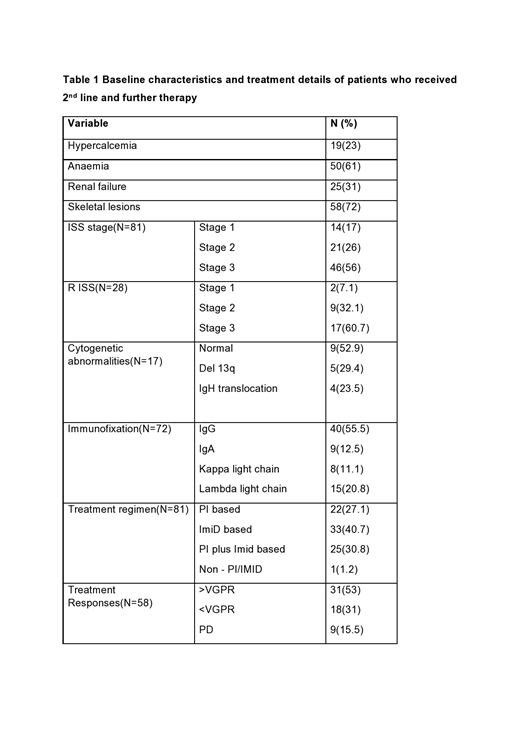Introduction:
Multiple myeloma is characterised by abnormal plasma cell proliferation leading to anaemia, hypercalcemia, skeletal lytic lesions and renal failure. Though myeloma is incurable, novel agents have improved the outcomes. Despite the availability of multiple new agents which lead to improvement in survival, majority of patients are still unable to receive second and further lines of therapy. The present study was designed to analyse the outcomes of patients who received 2nd line and later lines of therapy.
Materials and methods:
Data of all patients diagnosed with multiple myeloma from 2013-2018 was retrieved. Clinical, haematological, other significant lab parameters, treatment details were noted. For patients who progressed on 1st line therapy and those who had responses of less than PR, 2nd line therapy was started. PFS 2 was calculated from start of 2nd line therapy till progression. Survival probabilities were estimated by Kaplan-Meier method and compared by log rank test. SPSS 25 software was used for statistical analysis.
Results:
A total of 258 patients were diagnosed between 2013 and 2018. The median age at presentation was 56 years (range, 28-84 years). Male to female ratio was 2.03:1. Of these 258 patients, 191(74%) patients took planned therapy and 172(66%) patients had at least one response evaluation. Of these, only 81(47%) patients were able to receive 2nd line therapy. Five patients died during therapy, 16 patients did not complete planned therapy and 58(33%) patients had response evaluation. Seventy five percent of patients received triplet chemotherapy. MPT and VRD were the most commonly used regimens. Median number of cycles before response evaluation was 4 cycles. Of these 81 patients, 14(17.2%) patients underwent autologous stem cell transplantation. The baseline characteristics and outcomes were shown in Table 1. Twenty (34%) patients received 3rd line and further lines of therapy. Of these 20 patients, best response was VGPR, seen in 50% percent of patients. The median progression free survival (PFS2) was 15 months (range1-59 months). At a median follow up of 18 months, 2-year PFS was 61.6%. The 2-year OS of all patients and those who receive 2nd and later lines were 76% and 84% respectively.
Conclusion:
Only 30% of patients received second line and one tenth of all patients were able to receive third and later lines of therapy. Majority of the patients who received second and later lines of therapy had ≥ VGPR. Overall survival was higher in patients who received further therapy at progression. Outcomes in multiple myeloma can be improved by optimal sequencing of available drugs. Treatment discontinuity is major caveat in management of myeloma in real-world scenario and overcoming this challenge might improve survivals.
No relevant conflicts of interest to declare.
Author notes
Asterisk with author names denotes non-ASH members.


This feature is available to Subscribers Only
Sign In or Create an Account Close Modal